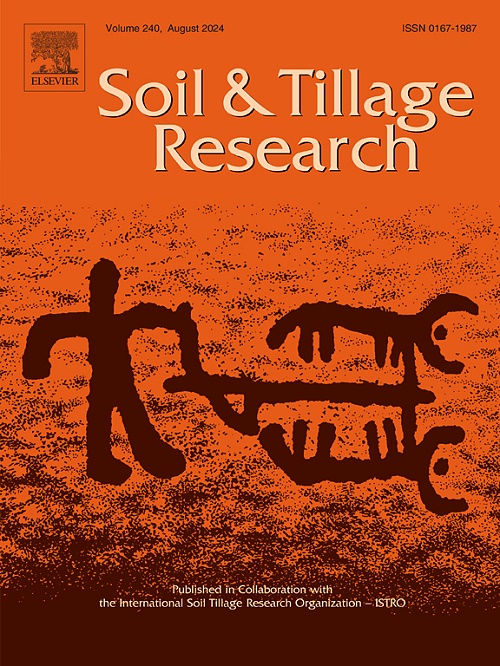中国不同植被类型坡面尺度径流预测的修正曲线数法
IF 6.8
1区 农林科学
Q1 SOIL SCIENCE
引用次数: 0
摘要
土壤保持服务曲线数(SCS-CN)方法被广泛用于估算地表径流,该方法依赖于SCS手册中的曲线数(CN)。然而,它对三种离散水文条件(HC)类别(如良好、一般、差)的依赖降低了对地表变率的敏感性,导致CN突变和径流估计不一致。为了提高CN估计的准确性,本研究基于中国65个监测点的降雨径流观测数据,使用中位数(CN _C)和最小二乘拟合(CN _F)方法评估了每个HC的CN值。虽然CN _F略微改善了CN估计,但仍然导致性能不理想,在许多HC条件下,Nash-Sutcliffe效率(NSE)值低于60 %,突出了分类HC分类和内部CN可变性的局限性。为了解决这个问题,该研究针对草地、灌丛和林地生态系统开发了三个方程,将CN值与裸露土壤和植被覆盖的表格CN值结合起来。该方法使用来自58个站点的数据进行校准和验证,并在7个独立站点进行了测试。结果表明,径流预测精度显著提高:草地NSE值从60.55 %(原始方法)提高到78.57 %,灌丛从58.51 %提高到82.90 %,林地从-21.20-64.39 %。在验证中也观察到类似的改善,草地的NSE从61.78 %增加到79.11 %,灌丛的NSE从57.46增加到81.28 %,林地的NSE从- 43.68增加到62.71 %。这些结果表明,该方法在中国不同植被景观的径流预测中具有优越的性能和更广泛的适用性。本文章由计算机程序翻译,如有差异,请以英文原文为准。
A modified curve number method for runoff prediction of different vegetation types at the slope scale in China
The Soil Conservation Service Curve Number (SCS-CN) method is widely used to estimate surface runoff, relying on the Curve Number (CN) from the SCS handbook. However, its reliance on three discrete hydrologic condition (HC) categories (e.g., good, fair, poor) reduces sensitivity to land surface variability, leading to abrupt CN changes and inconsistent runoff estimates. To enhance CN estimation accuracy, this study assessed CN values for each HC using the median (CN _C) and least-squares fit (CN _F) methods based on rainfall-runoff observations from 65 monitoring sites across China. Although CN _F slightly improved CN estimation, it still resulted in unsatisfactory performance, with Nash–Sutcliffe efficiency (NSE) values below 60 % under many HC conditions, highlighting the limitations of categorical HC classification and internal CN variability. To address this, the study developed three equations integrating CN values with tabulated CN values for bare soil and vegetation coverage, tailored to grassland, shrubland, and woodland ecosystems. This method was calibrated and validated using data from 58 sites and tested at 7 independent sites. Results showed marked improvements in runoff prediction accuracy: for calibration, NSE values increased from 60.55 % (original method) to 78.57 % for grassland, from 58.51 % to 82.90 % for shrubland, and from –21.20–64.39 % for woodland. Similar improvements were observed in validation, with NSE increasing from 61.78 % to 79.11 % for grassland, 57.46–81.28 % for shrubland, and –43.68–62.71 % for woodland. These findings demonstrate the superior performance and broader applicability of the proposed method for runoff prediction in China’s diverse vegetated landscapes.
求助全文
通过发布文献求助,成功后即可免费获取论文全文。
去求助
来源期刊

Soil & Tillage Research
农林科学-土壤科学
CiteScore
13.00
自引率
6.20%
发文量
266
审稿时长
5 months
期刊介绍:
Soil & Tillage Research examines the physical, chemical and biological changes in the soil caused by tillage and field traffic. Manuscripts will be considered on aspects of soil science, physics, technology, mechanization and applied engineering for a sustainable balance among productivity, environmental quality and profitability. The following are examples of suitable topics within the scope of the journal of Soil and Tillage Research:
The agricultural and biosystems engineering associated with tillage (including no-tillage, reduced-tillage and direct drilling), irrigation and drainage, crops and crop rotations, fertilization, rehabilitation of mine spoils and processes used to modify soils. Soil change effects on establishment and yield of crops, growth of plants and roots, structure and erosion of soil, cycling of carbon and nutrients, greenhouse gas emissions, leaching, runoff and other processes that affect environmental quality. Characterization or modeling of tillage and field traffic responses, soil, climate, or topographic effects, soil deformation processes, tillage tools, traction devices, energy requirements, economics, surface and subsurface water quality effects, tillage effects on weed, pest and disease control, and their interactions.
 求助内容:
求助内容: 应助结果提醒方式:
应助结果提醒方式:


